

Main/Evil Overlord List. Astarte. Astarte riding in a chariot with four branches protruding from roof, on the reverse of a Julia Maesa coin from Sidon Astarte /æˈstɑrti/ (Ancient Greek: Ἀστάρτη, "Astártē") is the Greek name of the Mesopotamian (i.e.

Assyrian, Akkadian, Babylonian) Semitic goddess Ishtar known throughout the Near East and Eastern Mediterranean from the early Bronze Age to Classical times. It is one of a number of names associated with the chief goddess or female divinity of those peoples.[1] She is found as Ugaritic 𐎓𐎘𐎚𐎗𐎚 (ʻṯtrt, "ʻAṯtart" or "ʻAthtart"); in Phoenician as 𐤕𐤓𐤕𐤔𐤀 (ʻštrt, "Ashtart"); in Hebrew עשתרת (Ashtoret, singular, or Ashtarot, plural); and appears originally in Akkadian as 𒀭𒊍𒁯𒌓 D, the grammatically masculine name of the goddess Ishtar; the form Astartu is used to describe her age.[2] The name appears also in Etruscan as 𐌖𐌍𐌉 𐌀𐌔𐌕𐌛𐌄 Uni-Astre (Pyrgi Tablets), Ishtar or Ashtart.
Overview[edit] Astarte was connected with fertility, sexuality, and war. See also[edit] Crystal invented that can store, release, and replenish oxygen on command. In what sounds like the most efficient weapon that an alien race can threaten the human populace with, scientists at the University of Southern Denmark have invented a crystal that pulls oxygen from a room and even water.

According to the researchers, only a bucket full of the crystalline material is needed for the effect to take place. The substance is a salt made from cobalt, and aside from rhyming, is capable of slurping up oxygen at 160 times the concentration of the air we breathe. While the new material sounds like something that will make the perfect weapon to toss into a room to control a crowd or to play a very mean prank on a coworker, the researchers state that “an excess” of the substance is what’s needed to make it impossible to breathe.
Perhaps even more sci-fi than a crystal that can suck up all the breathable oxygen, it can then later release that oxygen if exposed to heat or placed in scenarios where little oxygen is present. Professor McKenzie at the lab. Multidirectional invisibility cloak created by University of Rochester researchers. Fullerite: harder than diamond, and now made at room temperature. It sure does suck to be diamond, these days.
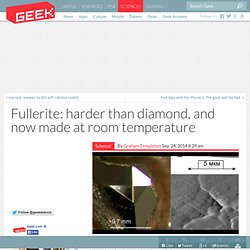
It seems like a day doesn’t go by that we don’t hear of diamond being bested in some way — despite its millennia-long reign as the king of all sorts of physical properties, diamond has fallen behind in many ways. In terms of hardness, an entire class of materials called “ultra-hard” have the gemstone beat, and in the case of super materials like graphene, the margin is not small. Still, diamond does have one big advantage over all these new fangled scientific rivals: the Earth has already done all the work of synthesis for us. The future of space suits could be in shrink wrap, not balloons. Looked at from a certain perspective, even ultra-modern space suits look a bit archaic.
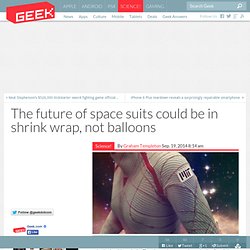
They have the general aesthetic of a diving bell, like a steam-punk imagining transported into space. The diving bell itself was basically a huge pressurized balloon, a way of taking the atmosphere at the surface down into the depths of the sea, but it’s very difficult to keep a balloon inflated against the crushing pressure of the deep; eventually, the bell gave way to modern diving suits, and divers learned how to deal with the pressure changes through behavior and specialized equipment. That’s made diving both safer and easier and more accessible than ever before, and now scientists think we might be able to do the same thing for space. Size Comparison - Science Fiction Spaceships by DirkLoechel on deviantART. Cyr wheel. The Cyr wheel (also known as the roue Cyr, mono wheel, or simple wheel) is an acrobatic device popularized in the early 21st century.
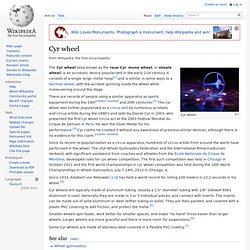
It consists of a single large, metal hoop[1] and is similar in some ways to a German wheel, with the acrobat spinning inside the wheel while maneuvering around the stage. There are records of people using a similar apparatus as sports equipment during the 19th[citation needed] and 20th centuries.[2] The cyr wheel was further popularized as a circus skill by numerous acrobats and circus artists during the 1990's and later by Daniel Cyr in 2003, who presented the first cyr wheel circus act at the 2003 Festival Mondial du Cirque de Demain in Paris. He won the Silver Medal for his performance.[3] Cyr claims he created it without any awareness of previous similar devices, although there is no evidence for this claim. If Disney Princesses Were Princes. Tumblr user Let There Be Doodles!
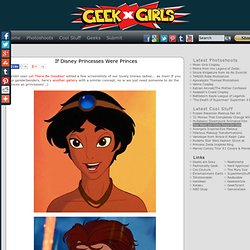
Edited a few screenshots of our lovely Disney ladies... as men! Brain-to-brain communication achieved across 5,000 miles. Water splitter runs on an ordinary AAA battery. Hongjie Dai and colleagues have developed a cheap, emissions-free device that uses a 1.5-volt battery to split water into hydrogen and oxygen.
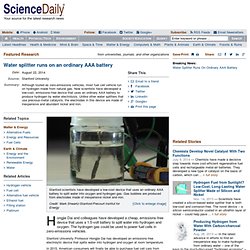
The hydrogen gas could be used to power fuel cells in zero-emissions vehicles. Stanford University Professor Hongjie Dai has developed an emissions-free electrolytic device that splits water into hydrogen and oxygen at room temperature. In 2015, American consumers will finally be able to purchase fuel cell cars from Toyota and other manufacturers. Although touted as zero-emissions vehicles, most of the cars will run on hydrogen made from natural gas, a fossil fuel that contributes to global warming. Now scientists at Stanford University have developed a low-cost, emissions-free device that uses an ordinary AAA battery to produce hydrogen by water electrolysis. In addition to producing hydrogen, the novel water splitter could be used to make chlorine gas and sodium hydroxide, an important industrial chemical, according to Dai.
Plants Can Hear Themselves Being Eaten. A small, flowering plant called Arabidopsis thaliana can hear the vibrations that caterpillars trigger when they chew on its leaves.

According to a new study, the plants can hear danger loud and clear, and they respond by launching a chemical defense. From anecdotes and previous studies, we know that plants respond to wind, touch, and acoustic energy. “The field is somewhat haunted by its history of playing music to plants. Not much force: Researchers detect smallest force ever measured. What is believed to be the smallest force ever measured has been detected by researchers with the Lawrence Berkeley National Laboratory (Berkeley Lab) and the University of California (UC) Berkeley.

Using a combination of lasers and a unique optical trapping system that provides a cloud of ultracold atoms, the researchers measured a force of approximately 42 yoctonewtons. A yoctonewton is one septillionth of a newton and there are approximately 3 x 1023 yoctonewtons in one ounce of force. "We applied an external force to the center-of-mass motion of an ultracold atom cloud in a high-finesse optical cavity and measured the resulting motion optically," says Dan Stamper-Kurn, a physicist who holds joint appointments with Berkeley Lab's Materials Sciences Division and the UC Berkeley Physics Department.
Stamper-Kurn is the corresponding author of a paper in Science that describes these results. The paper is titled "Optically measuring force near the standard quantum limit. " Ultra-thin wires for quantum computing. Take a fine strand of silica fiber, attach it at each end to a slow-turning motor, gently torture it over an unflickering flame until it just about reaches its melting point and then pull it apart.
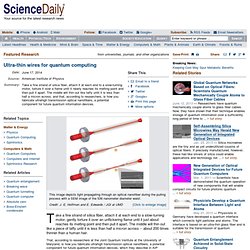
The middle will thin out like a piece of taffy until it is less than half a micron across -- about 200 times thinner than a human hair. That, according to researchers at the Joint Quantum Institute at the University of Maryland, is how you fabricate ultrahigh transmission optical nanofibers, a potential component for future quantum information devices, which they describe in AIP Publishing's journal AIP Advances. Invisible nano-barcodes could track explosives, drugs, and more. When forensic investigators first started using sophisticated ballistics analysis to identify criminals, it was viewed as an incredible insight.
Just a pattern of scratches on a hunk of half-destroyed metal could link a gun to a bullet — amazing! Today, impressing people is much more difficult; DNA evidence in particular has given us the sense that physical evidence can be analyzed to almost unlimited effect. Newly discovered neuron could repair the brain, make us smarter. A landmark study published by Duke University this week presents some truly important findings that, if true, could revolutionize our ability to repair the brain. Until now, the scientific understanding of brain neurons was that they do not regrow; our bodies make them during development, but once the brain is set it’s set, and it cannot repair itself like skin might after a slight injury. Yet this study claims to have identified a new type of neuron in the brain, one that can increase the activity of nearby neural stem cells.
This is early research, but it lays the foundation for incredible advances in medicine — and beyond. When scouring the brain for an in-road to helpful neural regeneration, this Duke study found a previously unknown class of neurons in the lateral walls of the brain. Teleporting information achieved by TU Delft. Illustration representing quantum information teleportation between diamonds (credit: TU Delft) Teleporting people through space, as in Star Trek, is impossible by the laws of physics, but researchers at TU Delft‘s Kavli Institute of Nanoscience have succeeded in teleporting information. Using quantum entanglement, they transferred the information contained in a quantum bit in a diamond to a quantum bit in another diamond three meters away, without the information having traveled through the intervening space.
The results were published in Science May 29. Tractor beam can move macro-scale objects with sound. “Tractor beams” are mostly mentioned in reference to starships; the phrase has probably been uttered more by science fiction characters than by everyone else combined. As a result, a new acoustic tractor beam recently unveiled in the journal Physical Review of Letters might not be quite what you’re expecting; since there’s no air between two starships, and thus no possibility of sound, an acoustic tractor beam could never work in space. Still, the breakthrough technology could find dozens of useful applications here on Earth, and pave the way for other, more space-friendly solutions. The physics at work here is both simple and complex, a dizzying confluence of wave mathematics that ultimately sum to allow the team to create a simple pulling force with sound. A wave diagram showing how the waves interact with their triangular object.
Closed timelike curve. In mathematical physics, a closed timelike curve (CTC) is a world line in a Lorentzian manifold, of a material particle in spacetime that is "closed", returning to its starting point. This possibility was first raised[citation needed] by Kurt Gödel in 1949, who discovered a solution to the equations of general relativity (GR) allowing CTCs known as the Gödel metric; and since then other GR solutions containing CTCs have been found, such as the Tipler cylinder and traversable wormholes. If CTCs exist, their existence would seem to imply at least the theoretical possibility of time travel backwards in time, raising the spectre of the grandfather paradox, although the Novikov self-consistency principle seems to show that such paradoxes could be avoided.
Femtotechnology. Colors Bees See. Colors Bees See. Flowers in Ultra-Violet. Picotechnology. World's thinnest nanowires created by Vanderbilt grad student. Why are there no green stars? - Bad Astronomy. Mimosa pudica. Mimosa pudica (from Latin: pudica "shy, bashful or shrinking"; also called sensitive plant, sleepy plant and the touch-me-not), is a creeping annual or perennial herb often grown for its curiosity value: the compound leaves fold inward and droop when touched or shaken, to protect them from predators, re-opening minutes later. The species is native to South America and Central America, but is now a pantropical weed.
It grows mostly in shady areas, under trees or shrubs. Description[edit] Cornus canadensis. Taxonomy[edit] Plant perception (physiology) The leaf closing after touch in Mimosa pudica depends upon electrical signals. Vine tendril. Note how the plant reaches for and wraps around the galvanised wire provided for the purpose. Hummingbird.
Synthetic diamond. 33 Unbelievable Places To Visit Before You Die. I Can’t Believe These Actually Exist On Earth… New way to filter light: May provide first directional selectivity for light waves. s3.amazonaws.com/kajabi-media/attachments/16762/GLS_Module_2.pdf?AWSAccessKeyId=AKIAJQJ7TPUNH4FUNP6A&Expires=1395026582&Signature=7lIP1RjKwf%2BZDBzhJ4DbMdnxSX8%3D. Ching Shih. An animated map of global wind and weather. 6 Great Martial Arts for Killing a Man With Your Bare Hands. 4 Plasma Technologies That Put Video Game Weapons to Shame. Clouds seen circling supermassive black hole. How evolution shapes the geometries of life.
Cloud forest. One of the strangest animals on earth gets a little weirder. Disney Princesses Redesigned With Historically Accurate Outfits. 39 Innocent Gestures That Will Make People Overseas Hate You. From Ashes To Ashes To Diamonds: A Way To Treasure The Dead. Starpath: Glow-in-the-Dark, Energy-Efficient Technology to Illuminate Streets at Night. Harvard’s omniphobic coating will lead to perma-clean clothes. Impossible colors. Harvard creates brain-to-brain interface, allows humans to control other animals with thoughts alone. Mapping Emotions On The Body: Love Makes Us Warm All Over : Shots - Health News. Solitons in a crystal: New light source could serve in geo-navigation, search for Earth-like planets.
Starlite. Simulations back up theory that Universe is a hologram. Answers: Why don’t we collect solar power in space? LOTR-Personality-Chart4.jpg (1600×2800) PhD student accidentally discovers superconductive, light-sensitive crystal. Brain imaging can predict how intelligent you are, study finds. Magnetic 'force field' shields giant gas cloud during collision with Milky Way. FiberFix resin tape is 100 times stronger than duct tape. Answers: Why is all life carbon-based? Nanoscale textures used for optimal hydrophobic surfaces. Self-healing metal closes cracks when under stress. History Channel Shi Yan Ming. Tessenjutsu. Gender and the Body Language of Power. World's 10 Humans With Real Superpowers. Spider silk turned into electrical wire with carbon nanotubes.
Encyclopedia Mythica: mythology, folklore, and religion. Emotional Wreck, A 17 year old Russian girl has a doll-like face but physique of a body builder. She is a powerlifter. Memories of positive associations get written onto DNA. Self-replicating probes could explore the entire Milky Way in only 10 million years. Creepy acrylic spine turns dancers into instruments. Solar panels don’t have to be shiny black surfaces anymore.
Faster-than-light. What if our eyes could see a wider gamut of the electromagnetic spectrum? Impossible colors. The eyes have it: Seeing ultraviolet, exploring color. Someday you may ditch your two-factor authenticator for an electronic tattoo. Weightlessness of space used to design better materials for Earth. Sperm cells created from female embryo. STEPHEN HAWKING: How to build a time machine.
Gravitational wave. Small in size, big on power: New microbatteries the most powerful yet. Why the mantis shrimp is my new favorite animal. Sonoluminescence. Bone conduction. Goodbye keyboards: Wristband recognizes words you write in the air. Don't do it. Earthworm guts become factory for nanoparticles. Icists extend entanglement in Einstein experiment.
New chemical reaction could explain how stars form, evolve, and eventually die. Bussard ramjet.
Trapping flying qubits in a crystal (and getting them back out) Orders of magnitude (speed) Baryon. 10 Creepy Plants That Shouldn't Exist. Finding a direction of time in exotic particle transformations. 7 Superpowered Animal Senses You Won't Believe Are Possible. Neutrino. Xkcd.